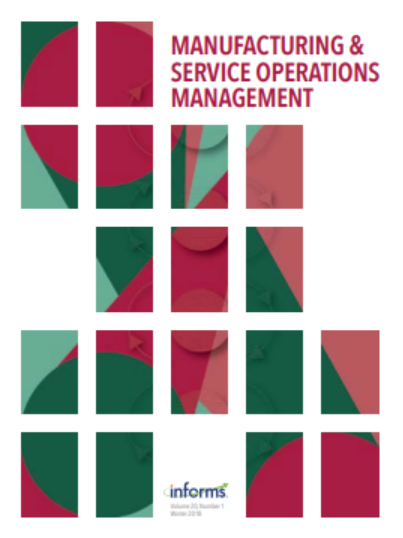行为和经济驱动因素对零工经济工作者的影响
IF 4.2
3区 管理学
Q1 MANAGEMENT
M&som-Manufacturing & Service Operations Management
Pub Date : 2023-07-01
DOI:10.1287/msom.2023.1191
引用次数: 3
摘要
问题定义:零工经济公司通过雇佣独立员工来应对实时需求,从而受益于劳动力灵活性。然而,员工在工作时间表上的灵活性在规划和承诺服务能力方面构成了巨大的挑战。因此,了解零工经济工作者的动机非常重要。我们与一个叫车平台合作,研究按需员工如何做出劳动决策;具体来说就是是否工作和工作时长。我们的模型回顾了关于经济激励和行为动机对劳动力决策影响的劳动力供给竞争理论。我们感兴趣的是改进如何预测灵活员工的行为,以及了解如何设计更好的激励措施。方法/结果:使用大型综合数据集,我们开发了一个计量经济学模型来分析工人的劳动决策和对激励的反应,同时考虑样本选择和内生性。我们发现,财政激励对工作决策和工作持续时间有显著的正向影响——证实了标准收入效应所假设的正收入弹性。我们还发现了行为理论的支持,因为工人表现出收入目标行为(达到收入目标后工作更少)和惯性(工作更长时间后工作更多)。管理意义:我们通过数值实验证明,基于我们的见解的激励优化可以在不产生额外成本的情况下将服务容量增加22%,或者以降低30%的成本保持相同的容量。忽略行为因素可能导致比最佳能力水平低10%-17%的人员不足。最后,我们的见解为在零工平台之间激烈竞争中管理灵活员工的平台策略设计提供了信息。资助:本研究由杰伊·h·贝克零售中心、威廉和菲利斯·麦克创新管理研究所、沃顿风险管理和决策过程中心以及菲什曼-戴维森服务和运营管理中心支持。补充材料:在线附录可在https://doi.org/10.1287/msom.2023.1191上获得。本文章由计算机程序翻译,如有差异,请以英文原文为准。
The Impact of Behavioral and Economic Drivers on Gig Economy Workers
Problem definition: Gig economy companies benefit from labor flexibility by hiring independent workers in response to real-time demand. However, workers’ flexibility in their work schedule poses a great challenge in terms of planning and committing to a service capacity. Understanding what motivates gig economy workers is thus of great importance. In collaboration with a ride-hailing platform, we study how on-demand workers make labor decisions; specifically, whether to work and work duration. Our model revisits competing theories of labor supply regarding the impact of financial incentives and behavioral motives on labor decisions. We are interested in both improving how to predict the behavior of flexible workers and understanding how to design better incentives. Methodology/results: Using a large comprehensive data set, we develop an econometric model to analyze workers’ labor decisions and responses to incentives while accounting for sample selection and endogeneity. We find that financial incentives have a significant positive influence on the decision to work and on the work duration—confirming the positive income elasticity posited by the standard income effect. We also find support for a behavioral theory as workers exhibit income-targeting behavior (working less when reaching an income goal) and inertia (working more after working for a longer period). Managerial implications: We demonstrate via numerical experiments that incentive optimization based on our insights can increase service capacity by 22% without incurring additional cost, or maintain the same capacity at a 30% lower cost. Ignoring behavioral factors could lead to understaffing by 10%–17% below the optimal capacity level. Lastly, our insights inform the design of platform strategy to manage flexible workers amidst an intensified competition among gig platforms. Funding: This study was supported by The Jay H. Baker Retailing Center, The William and Phyllis Mack Institute for Innovation Management, The Wharton Risk Management and Decision Processes Center, and The Fishman-Davidson Center for Service and Operations Management. Supplemental Material: The online appendices are available at https://doi.org/10.1287/msom.2023.1191 .
求助全文
通过发布文献求助,成功后即可免费获取论文全文。
去求助
来源期刊

M&som-Manufacturing & Service Operations Management
管理科学-运筹学与管理科学
CiteScore
9.30
自引率
12.70%
发文量
184
审稿时长
12 months
期刊介绍:
M&SOM is the INFORMS journal for operations management. The purpose of the journal is to publish high-impact manuscripts that report relevant research on important problems in operations management (OM). The field of OM is the study of the innovative or traditional processes for the design, procurement, production, delivery, and recovery of goods and services. OM research entails the control, planning, design, and improvement of these processes. This research can be prescriptive, descriptive, or predictive; however, the intent of the research is ultimately to develop some form of enduring knowledge that can lead to more efficient or effective processes for the creation and delivery of goods and services.
M&SOM encourages a variety of methodological approaches to OM research; papers may be theoretical or empirical, analytical or computational, and may be based on a range of established research disciplines. M&SOM encourages contributions in OM across the full spectrum of decision making: strategic, tactical, and operational. Furthermore, the journal supports research that examines pertinent issues at the interfaces between OM and other functional areas.
 求助内容:
求助内容: 应助结果提醒方式:
应助结果提醒方式:


